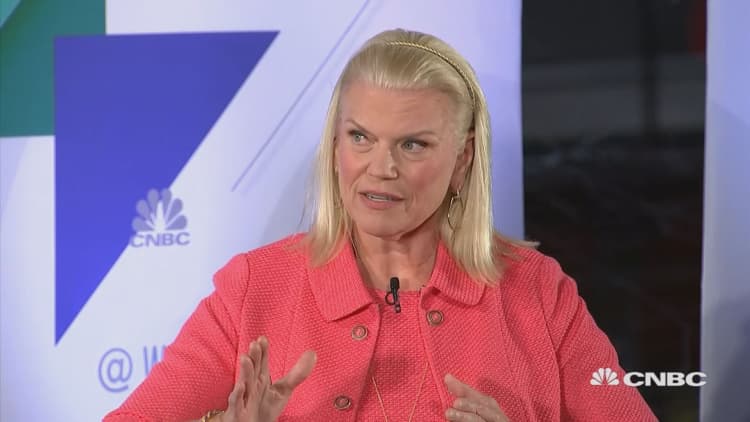The fastest-growing segment of the American workforce is employees age 65 and older. The reasons are many. Over the past decade, real wage growth has stagnated, pensions have disappeared, workers are delaying claiming Social Security benefits to maximize payouts, and lifespans are longer, leaving seniors worried they will burn through their retirement savings way too soon.
According to a Gallup 2018 survey of 1,015 adults age 18 and older across the United States, 41 percent of participants who are not retired plan to leave the job market at age 66 or older, a figure that has risen from 12 percent in the 1995 study and 26 percent in 2004. This number will likely keep growing.
Yet this hasn't changed the way most companies talk about their hiring priorities.
Many firms today focus more intently on how to recruit and retain millennials, and they base success on the percentage of their workers that now come from this younger generation.
Some job postings mention a "maximum number of years experience" or use a date-of-birth dropdown menu without an applicant's birth year listed. Words like "overqualified" can be code for too expensive. A corporate culture described as "fun" can suggest a workplace for the young. It is difficult for older workers to master the difficult interview process, and make discrimination claims once in a job.
Older workers are encountering widespread age discrimination, according to AARP. According to its 2018 Multicultural Work and Jobs Study, 61 percent of respondents over the age of 45 reported seeing or experiencing age-based discrimination in the workplace. What's more, senior workers are in a weakened position when it comes to a crucial workplace protection based on a recent Supreme Court decision and the legal safeguards that shield against wrongful termination or demotion, like claims covered under the Civil Rights Act.
"It's an open secret, and everyone knows it happens all the time, but few people stand up and say it's wrong," said Cathy Ventrell-Monsees, a senior attorney at the Equal Employment Opportunity Commission. "When it comes to age discrimination — stereotyping and comments — they seem too common."
Applicants and employees age 40 and older are protected from age discrimination in employment under the Age Discrimination in Employment Act, or ADEA, which was created in 1967 as an extension of Title VII of the Civil Rights Act, which doesn't cover age discrimination.
A 2009 Supreme Court ruling in "Gross v. FBL Financial Services, Inc.," however, set a higher bar for employees to prove that age was the deciding factor in an age discrimination claim that wasn't applied similarly to race, color, religion, sex or national origin.
Congress introduces bipartisan legislation
There is a new effort on Capitol Hill to restore the pre-Gross standard and allow workers to use "any type of admissible evidence" to prove age discrimination. The Protecting Older Workers Against Discrimination Act, also known as POWADA, was recently introduced by powerful sponsors: Sens. Chuck Grassley, a Republican from Iowa; and Bob Casey, a Democrat from Pennsylvania. In the House it is being sponsored by Reps. Bobby Scott, a Democrat from Virginia; and Jim Sensenbrenner, a Republican from Wisconsin.
But similar legislation has been introduced twice before, and Boston-based employment lawyer Shannon Liss-Riordan said it has never been enough of a focus to muster the votes to pass.
"I think this act is very important to strengthen protections for older workers so they're not excluded from the workforce earlier than they want to be based on bias," Liss-Riordan said.
In 1991, Congress amended Title VII of the Civil Rights Act to incorporate what is known as a mixed-motives model for discrimination claims, which meant that if the employee demonstrated that the person's race, color, religion, sex or national origin was a motivating factor in the adverse action, like demoting or firing, placed on the employee, the burden of proof shifted to the employer. If the employer could demonstrate that it would have taken the same action in the absence of those factors, the court could still hold the employer liable for the discriminatory action, but the employer would avoid paying damages, although the employee could still be awarded attorneys' fees.
The question remained whether the mixed-motives model applied to age, but the court's decision in "Gross" established that it would not apply similarly to the ADEA. This placed a heavier burden of proving age discrimination on the employee rather than shifting it to the employer as it is under Title VII.
The recently introduced legislation would restore the legitimacy of mixed-motive claims that would allow plaintiffs to prove age is a motivating factor, if not the deciding factor, in the negative actions taken against them, according to the act.
"For both older workers and employers, this bill is something they should be paying attention to," said Cristina Martin Firvida, vice president for financial security at AARP.
The bill could have a better chance in this legislative session now that one of its key sponsors, Rep. Scott, is chairman of the House Committee on Education and Labor, Martin Firvida said. Sen. Susan Collins, a Republican from Maine and chairman of the Senate Special Committee on Aging, has also thrown her support behind the bill.

"As more Americans are choosing to remain in the workforce longer, it is imperative that older workers are protected against age-based discrimination," said Senator Casey in an email. "An important first step is to pass my bill, the Protecting Older Workers Against Discrimination Act, that would make it easier for workers to fight back against age discrimination and has bipartisan support in both the Senate and House. With 10,000 people turning 65 every day, the time to act is now and I think Congress is taking note."
Rick Rossein, professor and employment law expert at City University of New York School of Law, said the legislation would also combat stereotypes that arise about older employees, especially in industries like technology. This would include instances where people are terminated or demoted because their skills don't meet the company's needs, rather than the employers providing training programs to bring older employees up to speed.
Government sees rise in diverse age claims
The EEOC also has seen an increase in age discrimination filings from older women and minorities since 2010, said Ventrell-Monsees, a senior attorney at the Equal Employment Opportunity Commission. Older women receive more rejections in the hiring process than men, in addition to minorities. The percentage of workers 55 or older participating in the labor force has grown significantly since 2000, and the EEOC found in a study that the number of black and Asian people filing charges of age discrimination nearly doubled compared to 1990 figures.
"In the charges the EEOC receives, there's been a significant increase in the diversity of people filing age discrimination charges," Ventrell-Monsees said. "In 1980s data, it's mostly white men. Now filings from older workers of color have increased."
It's difficult for someone to push back against employers, because there's a lot of fear of being retaliated against.Shannon Liss-RiordanBoston-based employment lawyer
Technology has made it easier in recent years for companies to target job candidates by age in ways that can be seen as discriminatory based on federal law. Facebook, which was sued in March by the U.S. government's Department of Housing and Urban Development for targeting certain consumers for housing ads, also allowed advertisers in recent years to target younger users with job advertisements while withholding the ads from older Facebook users. Facebook banned that advertising practice earlier this month, before the housing lawsuit.
A Facebook spokesman told The Washington Post that the company was "surprised" by HUD's decision to sue and had been working with HUD to address concerns and has "taken significant steps to prevent ads discrimination." He said Facebook and HUD talks were complicated by the government agency's request for access to user data. "While we were eager to find a solution, HUD insisted on access to sensitive information," the Facebook spokesman said, adding that the company continues to work with civil rights groups on the issue.
Other large companies are facing legal issues related to older workers.
Liss-Riordan, the Boston-based employment lawyer, is working with former IBM employees on age-based discrimination claims. Her legal actions on behalf of employees contend that the tech company systematically laid off older workers while actively investing in new, younger employees. So far, Liss-Riordan has filed over 60 arbitration cases against the company and said another roughly 60 employees who were not subject to arbitration clauses in separation contracts from the company have opted into a separate class-action.
A partner at Lichten & Liss-Riordan, her workplace lawsuits have targeted Amazon, Google and, most recently, a lawsuit against Uber challenging the company's classification of drivers as independent contractors that was settled for $20 million. Liss-Riordan, a potential political star rising, recently announced she's considering a primary challenge against Massachusetts Senator Edward Markey.
There was also a separate lawsuit filed by a group of former IBM employees in the federal district court in New York City on March 27 that charges the company with improperly preventing workers from joining together to charge IBM with discrimination. The employees are asking the court to invalidate a written agreement they made with IBM that requires them to waive their right to challenge the company in court in exchange for severance pay. If they win, it could expose the company to potential lawsuits from thousands of former IBM workers laid off in recent years.
The case against IBM comes after a ProPublica investigation alleged that 20,000 U.S.-based IBM employees ages 40 and over had been laid off as the company restocked with younger, less-experienced and lower-paid workers.
IBM defended its heavy investment in skills and retraining programs in response to the ProPublica investigation, with an IBM spokesman telling the publication, "We are proud of our company and our employees' ability to reinvent themselves era after era, while always complying with the law. Our ability to do this is why we are the only tech company that has not only survived but thrived for more than 100 years."
An IBM spokesman told CNBC, "IBM does not discriminate, and makes its employment decisions based on skills, not age."
At CNBC's recent @ Work Talent + HR Summit, IBM CEO Ginni Rometty told the audience the company spends nearly $500 million on retraining employees and consistently evaluates its employees' skills to remain relevant to the company and the market.
"I think one of the most important things we all can do is give people clear paths to opportunity," Rometty said. "One would be transparency of what the skills are needed in the company."

Liss-Riordan believes the evidence against IBM is strong, but said that any age discrimination case would have been easier to win over a decade ago before the Supreme Court's ruling. She does believe that building class-action lawsuits reduces plaintiff's fears of filing claims alone and, specifically with age discrimination cases that can be hard to prove, lawyers are able to gather stronger evidence of wrongdoing. Liss-Riordan said if the federal court challenge over arbitration succeeds, she will be working with the lawyers who brought that case. But if it does not, she will continue fighting on behalf of the former IBM employees.
She stressed that this isn't just a tech industry issue, where it is assumed recent college graduates will be able to keep up with the most recent trends better than older employees. Age discrimination can happen in any industry. The EEOC reached a $12 million settlement in 2017 with restaurant chain Texas Roadhouse, which alleged the company had violated the ADEA by denying older workers front-of-house-positions. Texas Roadhouse did not admit any wrongdoing in reaching the settlement, but agreed to change its hiring and recruiting practices as part of the settlement.
"Age discrimination is unfortunately common, and it's hard for people to pursue their rights," Liss-Riordan said. "Whether it's low-wage workers, who we are often representing, to laid-off executives at IBM, it's difficult for someone to push back against employers, because there's a lot of fear of being retaliated against."
How to file a charge of employment discrimination
A charge of discrimination is a signed statement asserting that an organization engaged in employment discrimination. The laws enforced by EEOC, except for the Equal Pay Act, require you to file a charge before you can file a lawsuit for unlawful discrimination.
Time limits for filing a charge
Where the discrimination took place can determine how long you have to file a charge. The 180-calendar-day filing deadline is extended to 300 calendar days if a state or local agency enforces a state or local law that prohibits employment discrimination on the same basis. The rules are slightly different for age discrimination charges. For age discrimination, the filing deadline is only extended to 300 days if there is a state law prohibiting age discrimination in employment and a state agency or authority enforcing that law. The deadline is not extended if only a local law prohibits age discrimination.
Online
A discrimination charge can be completed through the EEOC's online system after you submit an online inquiry and the EEOC conducts an interview. The EEOC's Public Portal asks you a few questions to help determine whether EEOC is the right federal agency to handle your complaint involving employment discrimination.
In person at the EEOC
You can schedule an appointment with the EEOC through the EEOC's Public Portal. Walk-in appointments are also available at EEOC offices. Go to https://www.eeoc.gov/field/index.cfm for information about the office closest to you.
By telephone
The EEOC does not take charges over the phone, but you can get the process started over the phone. You can call 1-800-669-4000 to discuss your situation. A representative will ask you for some basic information to determine if your situation is covered by the laws we enforce and explain how to file a charge.
For more methods to file a claim, visit the EEOC's website.
Source: U.S. Equal Employment Opportunity Commission






